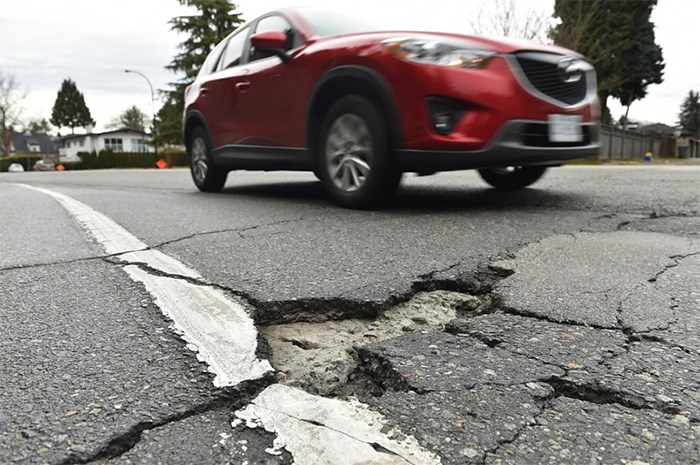 The City of Vancouver expects to repair 46,000 potholes this year, compared to Toronto’s 200,000. photo Dan Toulgoet
The City of Vancouver expects to repair 46,000 potholes this year, compared to Toronto’s 200,000. photo Dan Toulgoet
According to the City of Vancouver, its street crews will repair aproximately 46,000 potholes this year.
Potholes typically form on older road surfaces due to freezing and thawing weather. Over time, water freezing and expanding in the pavement weakens it and causes it to crack. The weight of vehicles passing over top can then break the material and displace it, leaving behind a hole. Due to Toronto’s more severe weather, that city typically repairs about 200,000 potholes a year.
The City of Vancouver maintains 1,445 kilometres of roads and bridges annually and the highest amount ever spent on pothole repairs was $720,271 in 2017.
According to Be Car Care Aware, a program that promotes the benefits of regular vehicle maintenance and repairs, potholes are an inevitable part of living in a multi-season environment, which most of Canada experiences, and spring is typically when we see our first crop of these hazards. Potholes can also show up sooner during milder winters.
And while their presence can’t be avoided there are a few things you can do to help your car make it through this unofficial season unharmed.
- Be attentive — potholes can appear very quickly especially after a rainfall and a short freeze/thaw cycle. Drive the speed limit and don’t follow other vehicles too closely.
- Check your tire pressure. Keeping your tires (all four) at the recommended air pressure will help cushion some of the impact. Proper air pressure will also help with traction in case of a sudden stop — like when the vehicle in front of you swerves to avoid a pothole.
- Try to avoid erratic swerving as sudden movement could cause you to hit another vehicle. Just as you wouldn’t want someone to swerve dangerously in front of you, keep your vehicle under control at all times.
- If hitting a pothole is inevitable, don’t slam on the brakes. You’ll force the weight of your car forward and down into the pothole, causing even more damage.
How do you know if you’ve damaged your vehicle?
- Your steering will pull to either the right or the left — this is your alignment and is needed for vehicle handling and proper tire use.
- If you feel as though your vehicle is swaying left to right, especially when turning corners, or is bouncing/bottoming out, your suspension may have been compromised. This type of damage could affect anything from your shocks, struts and ball joints to your steering rack, bearings, seals and tie rods.
- Visually inspect your tires looking for cuts or bulges along the rubber. Look for bends or cracks in the rims. This type of damage may seem superficial but could, at higher speeds, cause a blowout.
- If you do hit a pothole, take a minute or two, as soon as it is safe to do so, to visually inspect your vehicle and make special note of any damage to the tires. If you see any damage or feel like your vehicle just isn’t driving the way it normally does, visit your local automotive service provider for a quick inspection.
For more information visit becarcareaware.ca.


